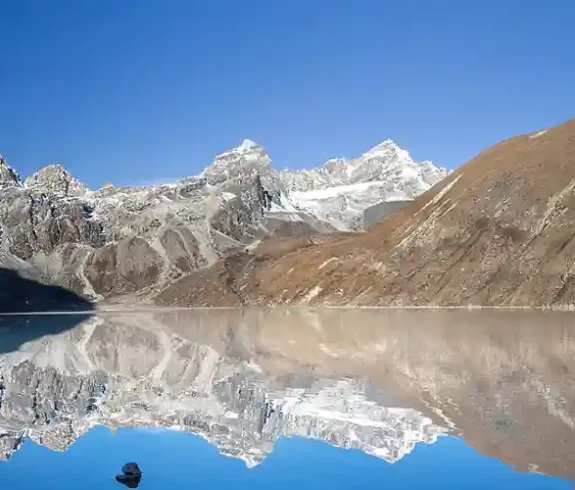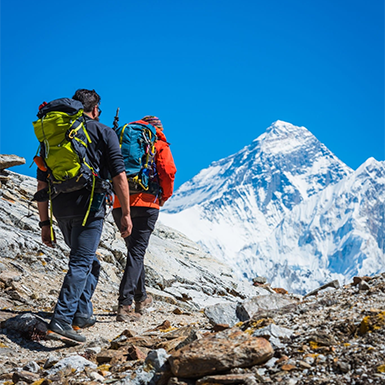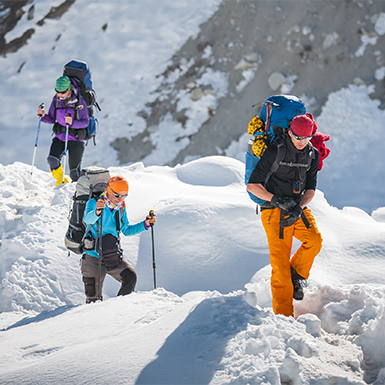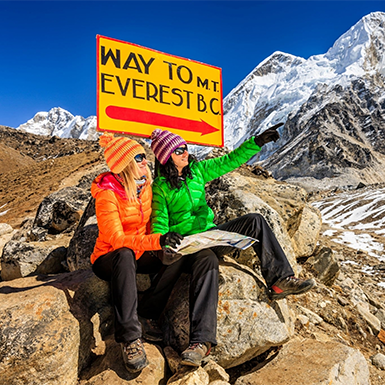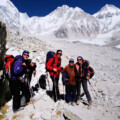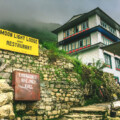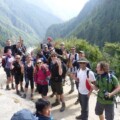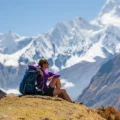Gokyo Lakes is a hidden gem in the Everest region, known for its breathtaking beauty. The turquoise waters of the lakes, surrounded by towering Himalayan peaks, create a serene and awe-inspiring landscape that captivates every visitor. The vibrant colors of the lakes contrast beautifully with the stark white of the surrounding glaciers, making it a must-visit destination for nature lovers and adventure seekers alike.
These natural wonders provide unparalleled vistas of Everest, Lhotse, and Makalu. Gokyo’s tranquility, combined with the majestic backdrop of the Himalayas, provides a perfect setting for those looking to experience Nepal’s untouched beauty.
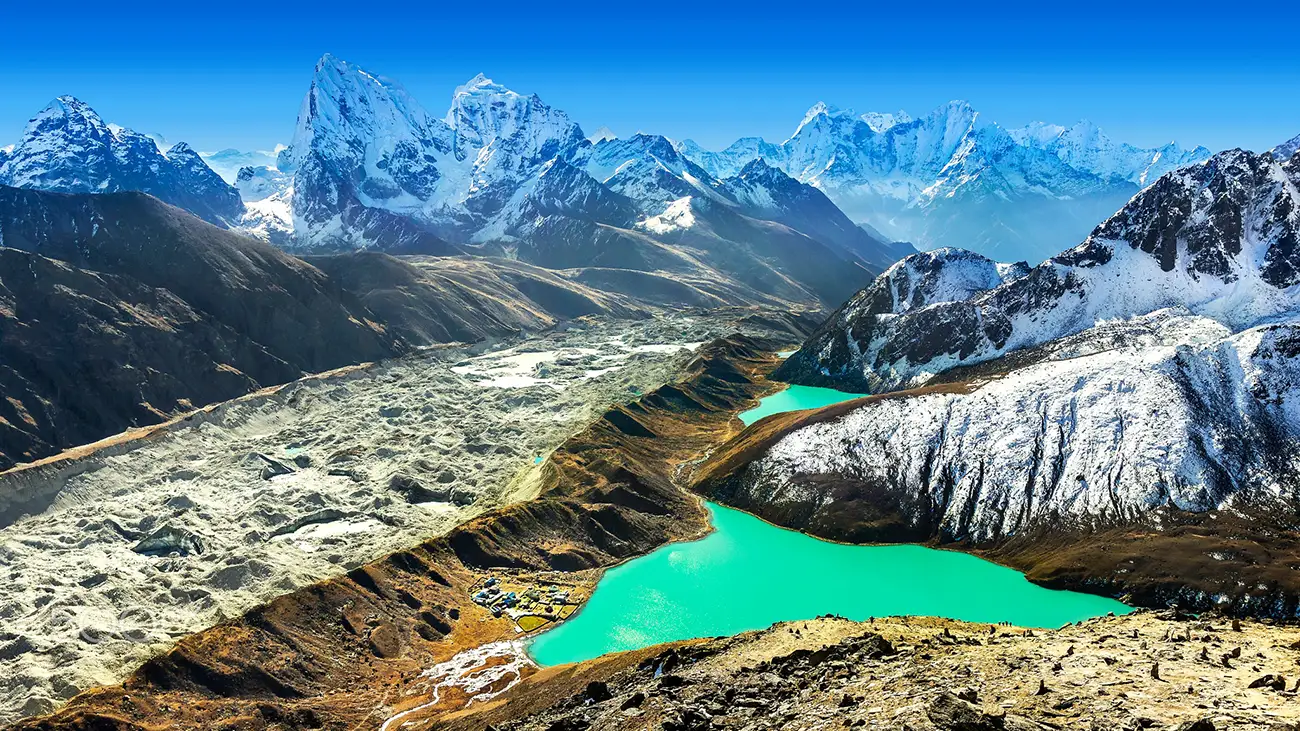
Location: Sagarmatha National Park’s Gem
The UNESCO World Heritage-listed Sagarmatha National Park in Nepal’s Everest region cradles the picturesque Gokyo Lakes. These pristine waters, ranging from 4,700 to 5,000 meters, lie in the Gokyo Valley, bordering Nepal’s largest glacier, the immense Ngozumpa.
The area is accessible via the trek to Gokyo, a popular route among trekkers who wish to explore the less crowded trails of the Everest region. The trek commences in Lukla, winding its way through Phakding and the bustling hub of Namche Bazaar before meandering through a series of charming Sherpa villages. This trek provides a unique window into the local people’s vibrant culture and time-honored traditions.
Significance: Cultural and Spiritual Tapestry
The Gokyo Lakes hold deep cultural and spiritual significance for the Sherpa people, who consider these waters sacred. The lakes are associated with various legends and religious beliefs:
- Spiritual Reverence: The Sherpa community believes that deities reside in the lakes, and they perform rituals and prayers to honor these sacred waters.
- Annual Festival: Every year, during the Janai Purnima festival, hundreds of pilgrims visit the lakes to bathe in their waters, believing that it will purify their souls and bring good fortune.
- Preservation Efforts: The local communities are committed to preserving the sanctity and purity of the lakes, which are considered a vital part of their spiritual heritage. They have implemented various measures to protect the lakes from pollution and ensure their continued significance for future generations.
Gokyo Lakes Trek: A Tranquil Path to Himalayan Splendor
The Gokyo Lakes trek is captivating and celebrated for its serene beauty and awe-inspiring vistas. While the Everest Base Camp trek draws large crowds, the trek to Gokyo trek offers a quieter, equally rewarding experience for those seeking solace amidst the grandeur of the Himalayas.
The Route: From Lukla to Gokyo
This trek typically begins in the mountain town of Lukla, accessible via a scenic flight from Kathmandu. From there, the trail winds its way through picturesque Sherpa villages, verdant forests, and across suspension bridges that span rushing rivers. Key stops along the route include:
- Phakding: The charming village where the Dudh Koshi River flows is the perfect starting point to discover the area’s natural beauty.
- Namche Bazaar: The bustling Sherpa capital, a hub of activity with stunning views of Everest and Ama Dablam.
- Dole: A quaint village situated at a higher altitude, marking the transition to the alpine zone.
- Machhermo: A picturesque settlement known for its yak pastures and stunning views of Kangtega and Cho Oyu.
- Gokyo: The final destination is the village of Gokyo, home to the breathtaking Lakes and the towering Gokyo Ri.
Key Highlights: Himalayan Panoramas
The trek to Gokyo rewards trekkers with a series of unforgettable experiences:
- Breathtaking Views: The trek unveils spectacular vistas of the world’s highest mountains, including Everest, Lhotse, and Makalu.
- Gokyo Lakes: The trek reaches its zenith at the Gokyo, a collection of six pristine glacial bodies of water. Their turquoise waters, set against the backdrop of snow-capped peaks, create unparalleled beauty.
- Gokyo Ri Ascent: A challenging yet rewarding climb to Gokyo Ri (5,357 meters) offers arguably the best views in the Everest region, with a 360-degree panorama that encompasses the entire Gokyo Village, the Ngozumpa Glacier, and the majestic Himalayan range.
- Tranquility and Solitude: Compared to the more crowded Everest Base Camp trek, the trek to it offers greater peace and solitude, allowing trekkers to connect with the natural environment.

Gokyo Valley: Where Nature’s Grandeur Beckons
The majestic Himalayas cradle the Gokyo Valley, an unparalleled beauty and tranquility sanctuary. Renowned for its captivating Gokyo Lakes, this valley attracts trekkers and nature enthusiasts from far and wide. Encircled by towering peaks, the Gokyo Village presents a visual symphony of snow-capped mountains, glistening glaciers, and pristine turquoise lakes.
Glacial Marvels: The Ngozumpa Glacier
The Gokyo Valley’s glacial system, particularly the Ngozumpa Glacier, is a testament to nature’s might. This colossal ice flow, the largest in Nepal, stretches over 36 kilometers, sculpting the valley into a landscape of breathtaking beauty. The glacier’s ever-changing ice formations and sheer scale serve as a constant reminder of nature’s awe-inspiring power.
Discovering the Valley: Beyond the Lakes
While the Gokyo Lakes are undoubtedly the main draw, the Gokyo Village offers many opportunities for further exploration.
- Fifth Lake (Ngozumpa Tsho): For those seeking ultimate serenity, a detour to the Fifth Lake, also known as Ngozumpa Tsho, is necessary. This secluded lake, nestled at the foot of the Ngozumpa Glacier, offers breathtaking vistas and a profound sense of isolation.
- Cho Oyu Vistas: The Gokyo Village also offers awe-inspiring views of Cho Oyu, the world’s sixth-highest mountain. This majestic peak, towering at 8,201 meters, dominates the skyline, adding grandeur to the spectacular scenery.
- Sherpa Villages: As you traverse the valley, you’ll stumble upon charming Sherpa villages, offering a glimpse into the local culture and way of life. With their traditional stone houses and warm hospitality, these settlements infuse a touch of human connection into the pristine natural surroundings.
Everest Base Camp and Gokyo Lakes Trek: Gokyo Chola Pass Trek
The Gokyo Chola Pass Trek presents an unparalleled opportunity for trekkers yearning for an extended Himalayan odyssey. This ambitious route, merging two of the most iconic trails in the Everest region, offers a comprehensive experience of Nepal’s natural and cultural wonders.
Conquering the Cho La Pass
The linchpin of this combined trek is the formidable Cho La Pass, a high-altitude mountain pass connecting the Everest Base Camp and Gokyo. At an elevation of 5,420 meters (17,782 ft), the Cho La Pass is challenging and demands physical fitness and acclimatization. The crossing involves navigating steep ascents, rocky terrain, and potentially icy conditions. However, the rewards are immense, with breathtaking vistas of the surrounding peaks and glaciers.
Benefits of the Gokyo Chola Pass Trek
- Diverse Scenery: Experience a more comprehensive range of landscapes, from the lush forests of the lower valleys to the stark beauty of the high-altitude alpine zone.
- Cultural Immersion: Encounter diverse Sherpa communities and witness their unique way of life in the Khumbu and Gokyo villages.
- Iconic Landmarks: Visit Everest Base Camp, the starting point for Everest expeditions, and the serene Gokyo Lakes, nestled amidst towering peaks.
- Challenging Adventure: Test your limits with the Cho La Pass crossing, an accomplishment that will leave you with a profound sense of achievement.
- Unforgettable Memories: The combined trek creates lasting memories, from fellow trekkers’ camaraderie to the Himalayas’ awe-inspiring beauty.
Important Considerations
- Physical Fitness: The combined trek is physically demanding and requires good fitness and prior trekking experience.
- Acclimatization: Incorporating rest days and a steady climb into the itinerary is crucial for acclimatizing to the altitude and preventing altitude sickness.
- Weather: Be prepared for unpredictable mountain weather conditions, particularly during the monsoon and winter.
- Permits: Obtain the necessary trekking permits for the Everest and Gokyo regions.
- Guide and Porter: To make the most of your trek, hiring a local guide and porter can provide invaluable expertise and assistance.

Gokyo Ri Altitude: Conquering the Heights for Himalayan Vistas
Gokyo Ri, a renowned vantage point in the Everest region, draws trekkers with its promise of unparalleled panoramic views. Standing tall at a significant Gokyo Ri altitude of 5,357 meters (17,575 feet), reaching the summit presents a considerable physical challenge. Still, the reward is a visual spectacle that will forever remain etched in your memory.
The Challenge of Gokyo Ri Altitude
The trek to Gokyo Ri is not for the faint of heart. The Gokyo Ri Elevation tests endurance, even for experienced trekkers. As you ascend, the air thins noticeably, and every step demands more effort. However, the breathtaking scenery unfolding with each gain in elevation is a powerful motivator. The challenge of the Gokyo Ri Elevation is part of the adventure, pushing you to your limits and rewarding you with an unforgettable experience.
The Reward: A Himalayan Tapestry Unveiled
Reaching the summit of Gokyo Ri is an achievement that resonates deep within. The 360-degree panorama that awaits is simply awe-inspiring.
- Everest in its Glory: Witness the world’s highest peak, Mount Everest, in all its grandeur. The surrounding mountains, including Lhotse, Makalu, and Cho Oyu, create a breathtaking backdrop.
- Gokyo Lakes: Gaze down upon the shimmering turquoise waters of the Gokyo, nestled within the valley below.
- Ngozumpa Glacier: Marvel at the vast expanse of the Ngozumpa Glacier, the largest in Nepal, as it snakes its way through the landscape.
Sunrise and Sunset: Nature’s Masterpiece at Gokyo Ri Altitude
For an experience that transcends words, consider witnessing sunrise or sunset from the Gokyo Ri altitude. Witness the awe-inspiring spectacle of the Himalayas as the golden dawn breaks or the sun descends into a tapestry of shadows. The Gokyo Ri Elevation provides a front-row seat to this breathtaking display of nature’s artistry.
Weather: Navigating Nature’s Rhythms
Nestled high in the Himalayas, it is crucial in shaping your trekking experience. Understanding the seasonal variations and being prepared for potential challenges is essential for a safe and enjoyable trek.
Best Time to Visit: Optimal Weather
- Spring (March-May): As winter’s chill recedes, spring breathes life into the Gokyo Valley. Days are generally clear with mild temperatures, offering stunning views of the surrounding peaks. Escape the crowds and explore a landscape painted with wildflowers. It is a prime time to experience the favorable climate.
- Autumn (September-November): Post-monsoon, autumn paints the Gokyo region in warm hues. The clear skies and pleasant temperatures make it another ideal time for trekking. Breathe in the crisp air and soak up the vibrant landscape as you begin your adventure. The climate is generally stable and predictable during this season.
Seasonal Variations: Anticipating Weather Changes
- Summer (June-August): The monsoon season brings heavy rainfall, making trails slippery and challenging. While you can behold the lush greenery, prepare for limited visibility and potential delays due to the climate.
- Winter (December-February): Temperatures plummet, and snowfall is frequent. The trails become icy and difficult to navigate. However, winter offers a unique experience with fewer crowds and a pristine, snow-covered landscape. The climate can be harsh during this time, requiring extra preparation.
Impact on the Trek: Adapting to Weather
- Trail Conditions: Rain and snow can make trails slippery and increase the risk of falls. Exercise caution and use proper trekking gear.
- Visibility: Clouds and fog can obscure views, especially during the monsoon season. The weather in the Gokyo Lakes region can be unpredictable, so plan extra time for your itinerary.
- Temperature: Temperatures can fluctuate dramatically, especially at higher altitudes. Dress in layers and pack for warm and cold conditions to accommodate changes.
- Altitude Sickness: Weather can affect acclimatization. Pay close attention to your body and descend if you experience symptoms of altitude sickness, particularly in challenging climate conditions.
Packing Essentials
- Waterproof and Breathable Clothing: Pack a waterproof jacket, pants, and breathable layers for varying temperatures, as the weather can be unpredictable.
- Sturdy Trekking Boots: Invest in good-quality boots with ankle support to handle the rugged terrain, especially in wet or snowy climate conditions.
- Warm Layers: For colder temperatures, include fleece jackets, thermal base layers, and a warm hat and gloves, particularly during winter treks when the Gokyo Lakes Climate is harsh.
- Sun Protection: The high-altitude sun can be deceptive, even on cloudy days. Essential gear includes sunglasses, sunscreen, and a hat.
- Rain Gear: A rain poncho or umbrella is essential during the monsoon season when the climate is prone to heavy rainfall.
- First-Aid Kit: Carry a basic first-aid kit to address minor injuries and ailments.
Conservation and Environmental Impact at Gokyo
Gokyo, nestled in the Sagarmatha National Park, represents a delicate ecosystem that requires careful attention from all visitors. The area’s environmental sensitivity demands that every trekker adopt responsible practices to help preserve its natural beauty.
Preserving a Pristine Environment
Gokyo Lakes are among the highest freshwater lakes globally, which is crucial for local biodiversity. The area surrounding Gokyo Valley and Gokyo Village hosts unique flora and fauna, which are vulnerable to the increasing foot traffic of adventurers and trekkers heading towards Everest Base Camp and the trek to Gokyo Lakes. Efforts to safeguard focus on maintaining ecological balance and preserving the pristine condition of these glacial waters.
Steps to Minimize Ecological Footprints
Trekkers can significantly reduce their environmental impact at Gokyo Lakes, Nepal, by adhering to these guidelines:
- Waste Management: Carry out all non-biodegradable waste and ensure nothing is left behind to pollute the pristine environment of Gokyo Lakes, Nepal.
- Sustainable Products: Choose biodegradable personal care products to avoid contaminating the water sources around Gokyo Lakes.
- Trail Discipline: Stick to established trails to prevent soil erosion and protect native plant life in Gokyo Valley.
- Wildlife Respect: Observe wildlife from a distance without feeding or disturbing them, ensuring their natural behaviors remain intact.
Contributing to Local Conservation Initiatives
Supporting local conservation projects can enhance your impact on preserving the Gokyo Lakes in Nepal. Engage with community-led initiatives, use local services, and contribute to sustainable tourism practices that benefit the region’s ecological health and economic stability.
Capturing the Splendor of Gokyo: Ethical Photography Practices
When trekking through the breathtaking landscapes of Gokyo Lakes, it’s natural to want to capture every moment. The vibrant beauty of Gokyo, the rugged terrain of Gokyo Valley, and the awe-inspiring heights of Gokyo Ri offer endless photographic opportunities. However, responsible photography is crucial to preserving this pristine area’s natural and cultural integrity.
Understanding Ethical Photography
Photography at Gokyo goes beyond just taking pictures. It involves respecting the environment and the local communities. Here’s how you can ensure your photography respects the locale:
- Respect Local Customs: Some areas around Gokyo Lakes may have cultural sensitivities towards photography. Always ask permission before photographing local people or religious sites in and around Gokyo Village.
- Minimize Your Impact: While capturing the beauty of Gokyo Lakes, ensure you do not disrupt the natural setting. Stick to the trails and avoid trampling vegetation to get the perfect shot.
Best Practices for Outdoor Photography
- Use Natural Light: The natural light in Gokyo Valley provides perfect conditions for dramatic and soft images, especially during golden hours, shortly after sunrise and before sunset.
- Landscape Compositions: The reflective Gokyo Lakes offer stunning mirrored views of nearby peaks, including the iconic Everest Base Camp trek.
- Weather Awareness: Weather can change rapidly, offering dynamic and diverse photographic conditions. Capture the fog rolling in or the clear starry nights, but always prepare for sudden weather changes.
Gear Recommendations
- Choosing the Right Equipment: A good-quality camera with various lenses (wide-angle and zoom) is ideal for the diverse landscapes of Gokyo Lakes, Nepal. Remember spare batteries and memory cards, as cold weather can drain battery life quickly.
- Protection Against Elements: Weather at high Gokyo Ri altitude can be harsh. Protect your gear with waterproof and dustproof cases to ensure functionality in all conditions.
Leave No Trace
- Digital Over Physical: While collecting souvenirs is tempting, photographs can keep memories without taking anything from the site except images.
- Pack Out Trash: If you use props or consume food while shooting, ensure nothing is left behind. Maintaining the cleanliness of Gokyo Lakes helps preserve its allure and natural state.
A Himalayan Adventure Beyond Compare
As you plan your next trekking adventure, consider Gokyo, a destination with an unforgettable blend of natural beauty, cultural richness, and challenging treks. This region is not just a trek through the Himalayas; it explores one of Nepal’s most visually stunning and ecologically diverse areas.
Why Visit Gokyo Lakes?
Gokyo Lakes, Nepal, stand out as a premier destination for trekkers and nature lovers for several compelling reasons:
- Spectacular Scenery: The Gokyo Lakes offer a breathtaking panorama, where turquoise waters meet the sky-piercing snow-capped mountains.
- Diverse Trekking Routes: Whether exploring the Gokyo Village, ascending the challenging Gokyo Ri, or combining your trip with the Everest base camp and Gokyo lakes trek, the routes here cater to various skill levels and preferences.
- Rich Biodiversity: The region is not only beautiful but also home to a variety of flora and fauna, some of which are unique to the high-altitude ecosystem of the Himalayas.
- Cultural Experiences: The local Sherpa community in Gokyo Village offers trekkers a chance to experience and learn about a lifestyle that the rugged terrain of the mountains has shaped.
An Adventure Like No Other
Combine the physical challenge of a trek with the rewards of unparalleled natural beauty and authentic cultural encounters in Gokyo Lakes. The trek to Gokyo Lakes offers more than just a physical challenge; it’s a trek into the heart of the Himalayas that you will remember forever.
- Preparation is Key: Before you set off, ensure you’re well-prepared for the trek’s altitude and physical demands. Understanding Gokyo Lakes’ weather patterns is essential to planning your trek effectively.
- Respect the Environment: As you explore, respect the natural environment. Practicing eco-friendly trekking habits helps preserve this area for future generations.
